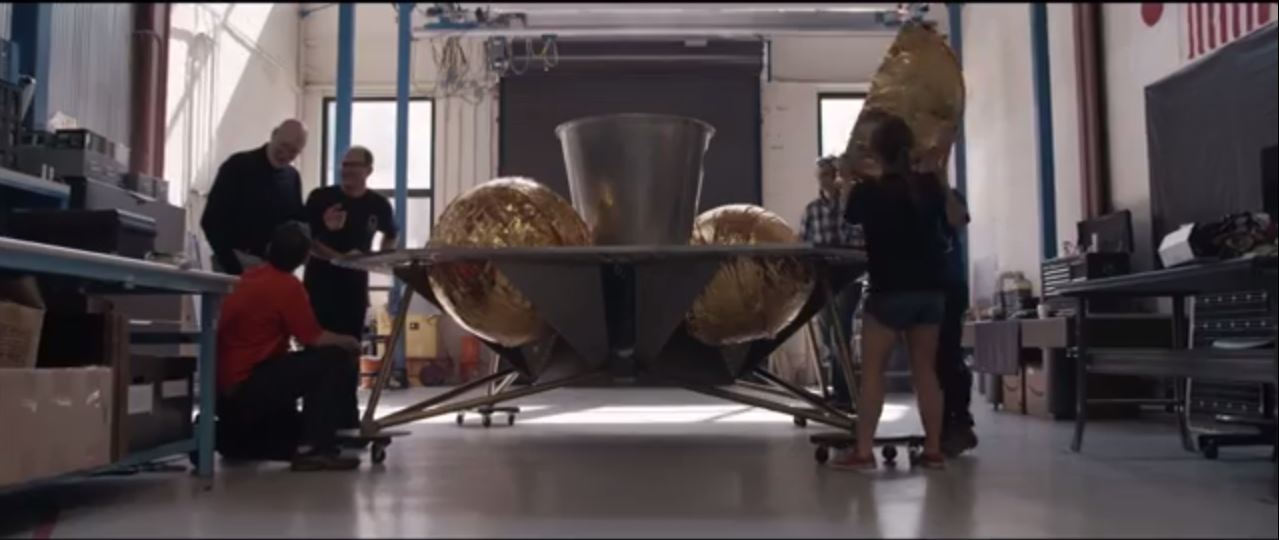'Moon Shot' Series Tells Personal Stories of X Prize Competitors

The J.J. Abrams-produced documentary series "Moon Shot," which focuses on the participants in the Google Lunar X Prize competition, tells the personal stories and struggles of seven people competing to put a working rover on the surface of the moon.
The nine-episode series, now available to watch for free on Google Play, gives viewers almost no information about the specific rover designs being engineered by any of the competition's 16 remaining teams. Instead, it tells some of the competitors' personal stories and explores their personal motivations for entering a competition to be one of the first private citizens to put a lander on the moon.
The opening episode follows roboticist Red Whittaker, a cheerful professor (who's also a business owner and a farmer) who has already built a very impressive legacy in his field. (In fact, he's been profiled here on Space.com.) Whittaker's multidecade robotics career makes him a far more likely competitor for the X Prize than some of the other participants profiled later in the series. [Watch the Trailer for 'Moon Shot']
For example, in the second episode of the series, viewers meet The Part-Time Scientists. This team comprises five young men, all of whom have no official training in robotics or aerospace, and had day jobs when they began the project. One worked as a game developer; another made dentist tools. Some of them have since started working full time on the project. They won two Milestone Awards from X Prize, which were given out to teams to assist them financially as they work toward the grand prize, and the secured a corporate sponsorship deal from Audi.
The team's leader, Robert Böhme, grew up in East Germany. In the series, he discusses the "crazy idea" that the German government had to "keep people from talking to each other" prior to the fall of the Berlin Wall. That part of Böhme's personal history is then contrasted with his current passion for open-source data sharing. He and his team have relied heavily on publicly available data from NASA and other space agencies to build their rover, he said in the series.
It's those kinds of details that the nine episodes highlight, frequently giving viewers glimpses at each team member's day-to-day life. (There are many shots of families eating dinner together.) There's also mention of recent personal struggles. For example, Episode 5 focuses on Kazuya Yoshida of Team Hakuto, who lives in a region of Japan hit hard by the 2011 tsunami. Episode 3 tells the story of Deepana Gandhi, a member of team Indus based in Bangalore, India. Though she had a natural mind for math, in the region where Gandhi grew up, she had very few opportunities to pursue a career in math or science because of her gender.
Each episode is about 7 minutes long, and the series also emphasizes the international level of competition — the 16 remaining teams are from 13 different countries. One episode follows a student in Mexico who belonged to one of four teams to win a worldwide robotics competition, Moonbots, sponsored by X Prize. The final episode tells a more general story about the wide range of participants.
Get the Space.com Newsletter
Breaking space news, the latest updates on rocket launches, skywatching events and more!
The lack of science and tech in the film series is almost frustrating, but some of that information is becoming available as the competition progresses. (There is also a blog where teams can write about their work on the X Prize website.) The number of teams remaining in the competition likely will drop on Dec. 31, 2016, the date by which all teams must have secured a launch contract if they wish to remain in the competition. So far, only two teams — Moon Express, based in the U.S., and SpaceIL, based in Israel — have secured contracts, X Prize representatives told Space.com.
To win the $20 million grand prize, the $5 million second prize or any of the "bonus" cash prizes, teams must land a rover on the lunar surface, have it travel 500 meters (1,640 feet), and send back high-definition video and images. They must complete their mission by the end of 2017.
The X Prize is a nonprofit foundation that started with the Ansari X Prize for suborbital spaceflight, in which competing teams were asked to build a private suborbital spaceship that could carry three human passengers and fly twice in two weeks. The winning design, called SpaceShipOne, was built and flown by Mojave Aerospace Ventures. The ship design is now owned by Virgin Galactic, the spaceflight company founded by billionaire Richard Branson.
Follow Calla Cofield @callacofield. Follow us @Spacedotcom, Facebook and Google+. Original article on Space.com.
Join our Space Forums to keep talking space on the latest missions, night sky and more! And if you have a news tip, correction or comment, let us know at: community@space.com.

Calla Cofield joined Space.com's crew in October 2014. She enjoys writing about black holes, exploding stars, ripples in space-time, science in comic books, and all the mysteries of the cosmos. Prior to joining Space.com Calla worked as a freelance writer, with her work appearing in APS News, Symmetry magazine, Scientific American, Nature News, Physics World, and others. From 2010 to 2014 she was a producer for The Physics Central Podcast. Previously, Calla worked at the American Museum of Natural History in New York City (hands down the best office building ever) and SLAC National Accelerator Laboratory in California. Calla studied physics at the University of Massachusetts, Amherst and is originally from Sandy, Utah. In 2018, Calla left Space.com to join NASA's Jet Propulsion Laboratory media team where she oversees astronomy, physics, exoplanets and the Cold Atom Lab mission. She has been underground at three of the largest particle accelerators in the world and would really like to know what the heck dark matter is. Contact Calla via: E-Mail – Twitter









